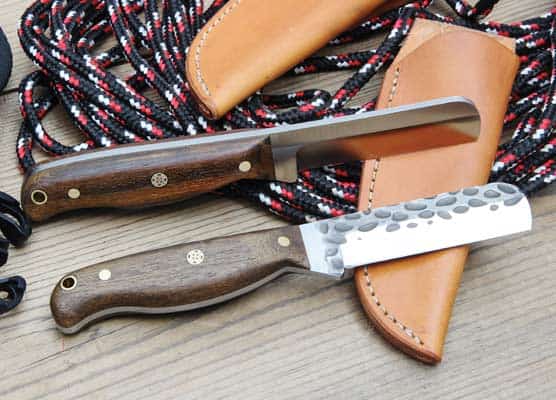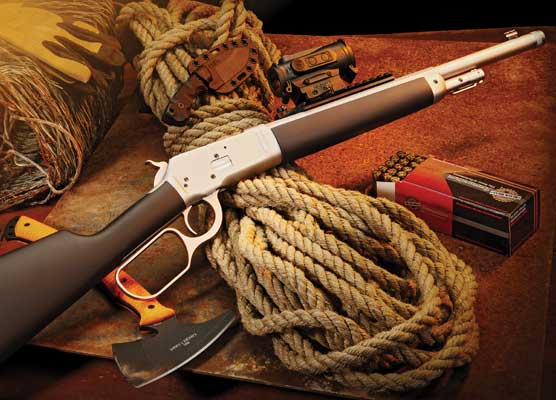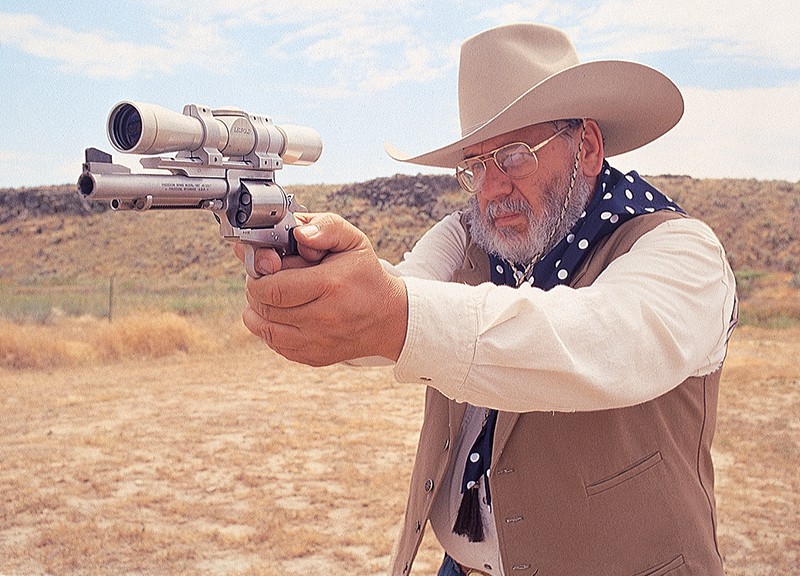| Up On ARs |
0
By Glen Zediker
Although we’ve cautioned on chamber dimensions numerous times over numerous years, this here bears repeating, and I’m here to do that. It’s important. If you’re the owner of a .223 Remington, know your chamber!
First: There are standards for cartridge dimensions and operating pressures. SAAMI—Sporting Arms and Ammunition Manufacturer’s Institute—is a voluntarily-given base of information that defines and delineates our modern centerfire cartridges. It’s essentially a voluntary agreement within our industry to standardize the specification for cartridge cases and chambers. That’s for the USA. The definitions include all the fine points on cartridges and chambers. SAAMI defines minimum and maximum headspace, for instance, and also chamber pressure maximums.
NATO—North Atlantic Treaty Organization—has its own set of standards for equivalent dimensions to standardize military specifications for ammunition in use by all the allies.
5.56 NATO is loaded to radically higher pressure than commercial-spec .223 Rem. There’s as much as 15,000 psi (pounds per square inch) difference. That’s enough to cause big troubles.
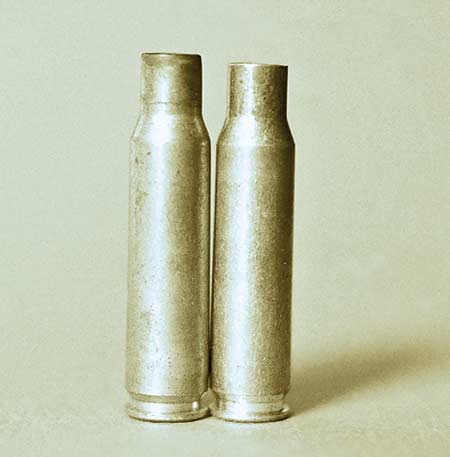
If you are a handloader and are loading for a 7.62 NATO, get a cartridge
case headspace gauge and subtract 0.004-inch from the spent case reading to
use as a figure to set your sizing die (case shoulder set-back). Don’t take
it to .308 specs or the case will break next use. Here’s a spent case from
the same ammo fired through a NATO-chambered rifle (left) and one fired
through my commercial .308 Win chamber (right). Yikes! Be aware a lot of
commercial-spec .308 Win ammo can literally come apart in a true NATO chamber.
The operative difference between 5.56 NATO and commercial .223 Rem is in the chamber “length,” which is specifically the leade or throat area. This portion of the rifle barrel extends from the cartridge case neck area in the rifle chamber to the start of the barrel’s lands or rifling. Some call it “freebore.” It’s the gap between the bullet sitting in a cartridge case neck and its first point of contact with the rifling. NATO is way on longer than SAAMI-defined standards for .223 Rem. When there’s more space ahead of a bullet, there’s more room for expanding propellant gases, and more room means “lower pressure.” Follow? The gas has additional space to occupy before it backs up against the bullet base.
The reason for this discrepancy goes on back to the original .223 Remington round, which was developed as a varminting-style cartridge for use in bolt-actions. Back in the day (early 1950s), the most common 0.224-inch bullets weighed 50 to 55 grains. These short little bullets, when loaded to a length suiting a magazine box, don’t “jump” too far in a .223 Remington chamber, and—almost always—better accuracy comes from starting the bullet nearer the lands. Less gap to clear before engaging the lands.
The SAAMI-spec .223 Rem chamber is also often called a “SAAMI-minimum” chamber because, once again, shortening the throat or leade is an asset to accuracy, over the narrow range of lightweight commercial 0.224-inch bullets. This coincidently is also what most of our manufacturers call a “match” chamber. It’s common on both factory-made and aftermarket barrels.
As suggested, the “conversion” of .223 Rem varmint round to military-spec combat round included bullets with a little different profile and also a stouter propellant load behind them.
It’s perfectly safe to fire “.223 Rem” commercial ammo in a NATO chamber, but it’s a one-way street! How do you know? Well, the barrel stamp should say “.223 Rem” or just “.223” if it’s a SAAMI-spec chamber. It should say “5.56” or “5.56 NATO” if it has a NATO chamber. Some I’ve seen aren’t marked… In that case I’d call the manufacturer, look closely in the operator’s manual, or measure it yourself. The surest and fastest way is to use a Hornady LNL Overall Length Gauge to check throat length.
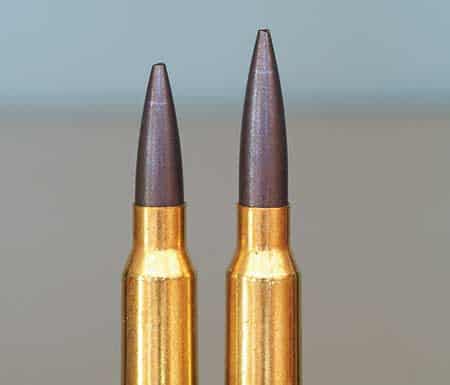
These two handloaded Sierra 80-grain MatchKings are seated to touch the
lands in a SAAMI-minimum .223 Remington commercial chamber (left) and a 5.56
NATO chamber (right). Whoa. There’s a solid 0.155-inch difference. But it’s
not about the bullet being jammed into the lands (not with a commercially-loaded
cartridge), it’s that the NATO round has much more space to accept the higher
pressure from burning propellant, and that’s the operative difference.
A “true” NATO round will have a cross inside a circle stamped into the head. Same here with barrels: a headstamp of “.223” or “.223 Rem” denotes SAAMI-spec, and “5.56” denotes NATO, along with the cross-in-circle. NATO-spec rounds are not all surplus or foreign manufacture! There are a good number of commercially-loaded mil-spec ammunition in the generic lines.
Most important is the fact you can’t tell by chambering a round. The other influential cartridge dimensions (overall round length, headspace, etc.) are patently the same for either standard. Learn your chamber, and buy ammo appropriately.
Now, there’s none to barely any difference between muzzle velocities of commercial 55-grain .223 and NATO 55-grain ammo. Doesn’t make sense if NATO is loaded to higher pressures, but it’s simple. It’s the difference in the throat volumes, again. The commercial takes less propellant to get to the same velocity, and the NATO takes more propellant to get to the same velocity. If that velocity is about 3,200 feet per second, it’s clear why there’s a difference in the propellant volume.
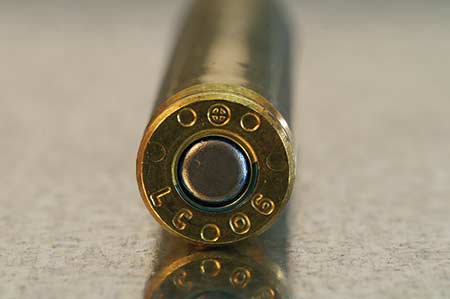
Look for the cross in the circle (above) as your clue ammo is “5.56.” Don’t
fire this in a commercial-spec .223 Remington chamber. What happens if you do
(below) is the case head takes a beating from the ejector and extractor (the marks
on the head are quite visible). The case head gets slammed against the bolt face
that much more forcibly.
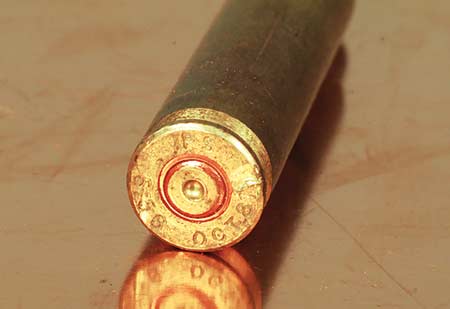
What about 7.62? Good question and I don’t often see an answer, so here’s mine: Like the 5.56/.223, the difference between commercial SAAMI-spec .308 Winchester and 7.62 NATO is in the chamber, but it’s in a different place. The difference in these two isn’t the throat, it’s the headspace. NATO is ridiculously longer. Although there are different pressure-testing standards used by NATO and SAAMI, .308 commercial ammo is actually loaded to a higher pressure maximum than mil-spec NATO. It’s safe to shoot NATO rounds in a .308 Win. chamber. The big difference comes in shooting commercial .308 in a NATO chamber. At the least, the commercial case will be way-stressed. Here’s a few numbers.
SAAMI-spec headspace for a .308 Win is a minimum (shortest headspace “GO” figure) of 1.630 inches, and then a “reject” (too long) figure of 1.634. Well, the number given as a minimum for NATO is 1.638 inches. The “reject” on NATO is 1.6455. I’m not at all clear on why anyone thought that was a good idea, but that’s what was done. It is also the reason NATO cartridge case specs call for much thicker-walled brass. No kidding. It has to endure that much more expansion. It’s a big reason to not purchase “surplus” 7.62 brass for reloading. Well that’s my advice. Cases fired through a true NATO chamber will be patently worthless to anyone owning a .308 Win.
The preceding is a specially-adapted excerpt from the new book, Top Grade Ammo, by Glen Zediker, available now at BuyZedikerBooks.com or call (662) 473-6107.
Purchase a PDF download of the January 2017 issue now!
